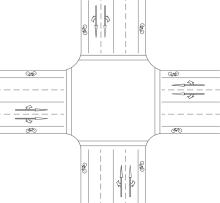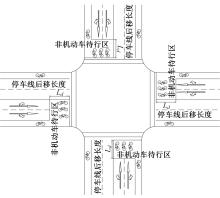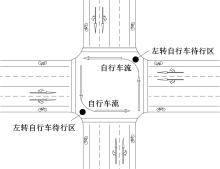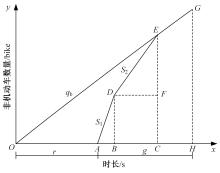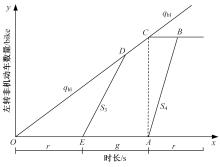吉林大学学报(工学版) ›› 2022, Vol. 52 ›› Issue (3): 550-556.doi: 10.13229/j.cnki.jdxbgxb20210258
• 交通运输工程·土木工程 • 上一篇
基于三种过街方式的两相位信号交叉口延误
冯天军1,2( ),孙学路1,黄家盛1,田秀娟1,2(
),孙学路1,黄家盛1,田秀娟1,2( ),宋现敏3
),宋现敏3
- 1.吉林建筑大学 交通科学与工程学院,长春 130118
2.吉林建筑大学 严寒地区交通防灾减灾工程研究中心,长春 130118
3.吉林大学 交通学院,长春 130022
Two-phase signal intersection delay based on three crossing modes
Tian-jun FENG1,2( ),Xue-lu SUN1,Jia-sheng HUANG1,Xiu-juan TIAN1,2(
),Xue-lu SUN1,Jia-sheng HUANG1,Xiu-juan TIAN1,2( ),Xian-min SONG3
),Xian-min SONG3
- 1.School of Transportation Science and Engineering,Jilin Jianzhu University,Changchun 130118,China
2.Engineering Research Center of Traffic Disaster Prevention and Control in Cold Region,Jilin Jianzhu University,Changchun 130118,China
3.College of Transportation,Jilin University,Changchun 130022,China
摘要:
从交通效率的角度出发,寻求两相位交叉口人均延误最小的过街方式,以车辆到达-驶离曲线为依据,结合韦伯斯特机动车延误模型,建立了非机动车传统过街、二次过街及机动车停车线后移3种延误模型。以人均延误为判别指标,描述了3种非机动车过街方式人均延误与车流流量的变化关系。通过对比3种机动车过街方式的交叉口人均延误,取延误最小者作为最优方式,为选择合适的非机动车交叉口过街方式提供了参考。
中图分类号:
- U491
| 1 | . 交通信号控制指南:德国现行规范(RilSA) [S]. |
| 2 | 李锐,郑长江,袁黎,等. 基于等效流率的两相位信号交叉口车均延误模型[J]. 长安大学学报: 自然科学版, 2015, 35(): 95-99. |
| Li Rui, Zheng Chang-jiang, Yuan Li, et al. Average delay model for two-phase signalized intersectionbased on equivalent traffic flow rate[J]. Journal of Ch-ang'an University(Natural Science Edition), 2015, 35(Sup.1): 95-99. | |
| 3 | 董亚茹. 人行横道交通延误计算方法与优化控制策略研究[D]. 北京: 北京交通大学交通运输学院, 2016. |
| Dong Ya-ru. Research on the calculation method of tra-ffic delay and optimal control strategy at the crosswalk[D]. Beijing: College of Transportation, Beijing Jiaotong University, 2016. | |
| 4 | 张亚平,陈烨,祁首铭,等. 信号控制交叉口转向延误概率模型[J]. 吉林大学学报:工学版,2020,50(6): 2113-2121. |
| Zhang Ya-ping, Chen Ye, Qi Shou-ming, et al. Model of controlled intersection turning delay based on probabilistic principle[J]. Journal of Jilin University(Engineering and Technology Edition), 2020, 50(6): 2113-2121. | |
| 5 | 李锐,李文权,邱丰. 考虑主路左转延误的主路优先交叉口信号设置流量阈值[J]. 东南大学学报:自然科学版, 2012, 42(3): 551-554. |
| Li Rui, Li Wen-quan, Qiu Feng. Signal setting critical volume for two-way stop controlled intersection based on major left-turn delay[J]. Journal of Southeast University(Natural Science Edition),2012,42(3): 551-554. | |
| 6 | 周晨静,荣建,冯星宇. 自行车对相邻直行机动车交通流干扰延误研究[J]. 北京工业大学学报,2015,41(5): 742-748. |
| Zhou Chen-jing, Rong Jian, Feng Xing-Yu. Effects of bicycle traffic on vehicular delays at signalized intersec-tions with pre-right-turn lanes[J]. Journal of Beijing University of Technology, 2015,41(5): 742-748. | |
| 7 | 别一鸣,汤茹茹,王运豪,等. 信号交叉口进口车道饱和流率估计方法[J]. 吉林大学学报: 工学版, 2019, 49(5): 1459-1464. |
| Bie Yi-ming, Tang Ru-ru, Wang Yun-hao, et al. Saturation flow rate estimation method of approaching lanes at signalized intersections[J]. Journal of Jilin University (Engineering and Technology Edition), 2019, 49(5): 1459-1464. | |
| 8 | Li Xi-guang, Li Guo-qiang, Pang Su-seng, et al. Signal timing of intersections using integrated optimization of traffic quality, emissions and fuel consumption: anote[J].Transportation Research Part D: Transport and Environment, 2004, 9(5): 401-407. |
| 9 | Gao Yu-hong, Qu Zhao-wei, Jiang Jing-ling, et al. Mix-ed traffic flow signal timing method considering E-Bi-ke expansion influence[J]. Journal of Transportation Engineering, Part A: Systems, 2021, 147(2): No. 04020155. |
| 10 | 马东方,王殿海,陈永恒. 两相位交叉路口最小信号周期时长[J]. 吉林大学学报:工学版, 2011, 41(2): 338-342. |
| Ma Dong-fang, Wang Dian-hai, Chen Yong-heng. Minimum cycle length of two-phase road intersection[J]. Journal of Jilin University (Engineering and Technology Edition), 2011, 41(2): 338-342. | |
| 11 | 陈永恒,白乔文,魏雪延. 设有待转区的左转专用车道车辆释放过程建模[J]. 交通运输系统工程与信息, 2014, 14(1): 174-179. |
| Chen Yong-heng, Bai Qiao-wen, Wei Xue-yan. Departure processes model for left-turn laneson waiting area[J]. Journal of Transportation Systems Engineering and Infor-Mation Technology, 2014, 14(1): 174-179. | |
| 12 | 顾晨阳. 二相位交叉口左转非机动车交通组织评价与方案比选研究[D]. 成都: 西南交通大学交通运输与物流学院, 2020. |
| Gu Chen-yang. Study on evaluation and screme selection of left turn non-motor vehicle traffic organization at two-phase intersections[D]. Chengdu: School of Transportation and Logistics, Southwest Jiaotong University, 2020. |
| [1] | 薛锋,何传磊,黄倩,罗建. 多式轨道交通网络的耦合协调度[J]. 吉林大学学报(工学版), 2021, 51(6): 2040-2050. |
| [2] | 贾彦峰,曲大义,林璐,姚荣涵,马晓龙. 基于运行轨迹的网联混合车流速度协调控制[J]. 吉林大学学报(工学版), 2021, 51(6): 2051-2060. |
| [3] | 陆文琦,周天,谷远利,芮一康,冉斌. 基于张量分解理论的车道级交通流数据修复算法[J]. 吉林大学学报(工学版), 2021, 51(5): 1708-1715. |
| [4] | 卢凯,吴蔚,林观荣,田鑫,徐建闽. 基于KNN回归的客运枢纽聚集人数组合预测方法[J]. 吉林大学学报(工学版), 2021, 51(4): 1241-1250. |
| [5] | 彭博,张媛媛,王玉婷,唐聚,谢济铭. 基于自动编码机-分类器的视频交通状态自动识别[J]. 吉林大学学报(工学版), 2021, 51(3): 886-892. |
| [6] | 张健,吴坤润,杨敏,冉斌. 智能网联环境下交叉口双环自适应控制模型[J]. 吉林大学学报(工学版), 2021, 51(2): 541-548. |
| [7] | 王殿海,沈辛夷,罗小芹,金盛. 车均延误最小情况下的相位差优化方法[J]. 吉林大学学报(工学版), 2021, 51(2): 511-523. |
| [8] | 宋现敏,张明业,李振建,王鑫,张亚南. 动态公交专用道的设置及其仿真分析评价[J]. 吉林大学学报(工学版), 2020, 50(5): 1677-1686. |
| [9] | 贾洪飞,丁心茹,杨丽丽. 城市潮汐车道优化设计的双层规划模型[J]. 吉林大学学报(工学版), 2020, 50(2): 535-542. |
| [10] | 尹超英,邵春福,王晓全,熊志华. 考虑空间异质性的建成环境对通勤方式选择的影响[J]. 吉林大学学报(工学版), 2020, 50(2): 543-548. |
| [11] | 张大伟,祝海涛. 考虑行人差异性的人群疏散最优决策理论模型[J]. 吉林大学学报(工学版), 2020, 50(2): 549-556. |
| [12] | 常玉林,袁才鸿,孙超,张鹏. 基于改进元胞传输模型的城市路网实际阻抗计算方法[J]. 吉林大学学报(工学版), 2020, 50(1): 132-139. |
| [13] | 宗长富,文龙,何磊. 基于欧几里得聚类算法的三维激光雷达障碍物检测技术[J]. 吉林大学学报(工学版), 2020, 50(1): 107-113. |
| [14] | 隋振,姜源. 基于MIMO类脑情感学习回路的横-纵向综合控制驾驶员模型[J]. 吉林大学学报(工学版), 2020, 50(1): 140-146. |
| [15] | 别一鸣,姜凯,汤茹茹,王琳虹,熊昕宇. 考虑方案过渡影响的单点交通控制时段划分方法[J]. 吉林大学学报(工学版), 2019, 49(6): 1844-1851. |
|
||
